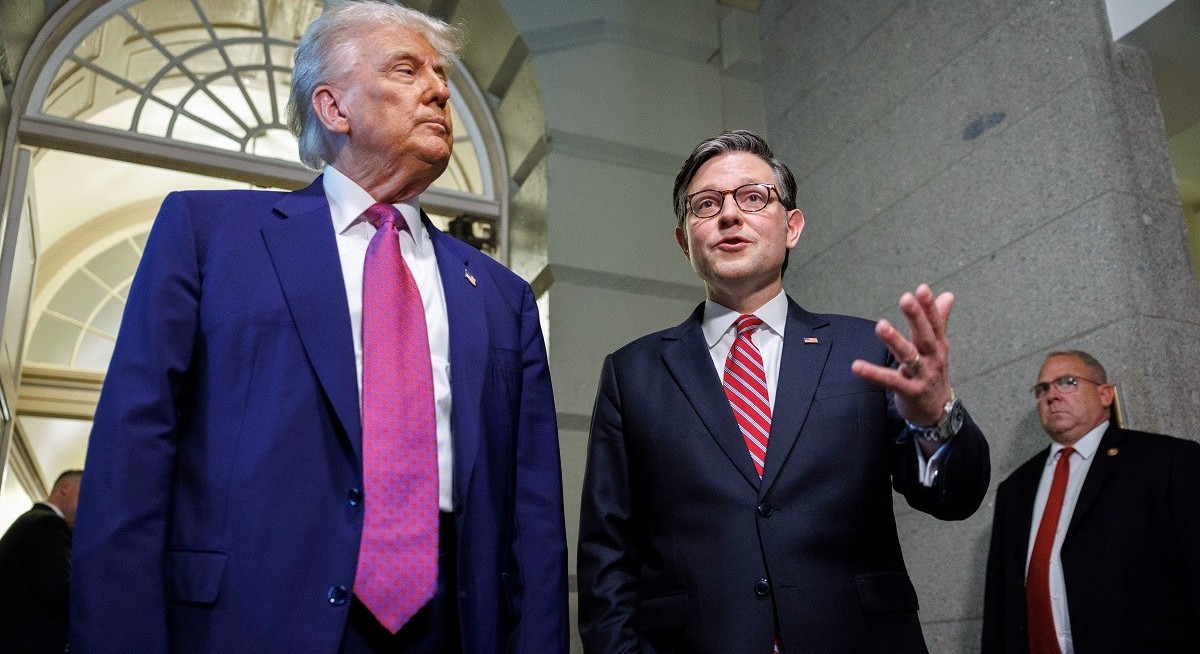In a vast understatement, the interest-rate strategists at BMO Capital Markets described the auction as “lackluster” in a note to clients. That’s an understatement because the poor auction sent yields for Treasuries of all maturities flying higher. Those on 10-year Treasuries — the global benchmark that helps determine borrowing costs for the government, businesses and consumers — rose to the highest since February, higher than the levels in early April that forced President Donald Trump to reverse course and soften his draconian tariff plan. Markets “were jumping a little bit out of line,” Trump told reporters at the time when asked why he backed off. “They were getting a little bit yippy, a little bit afraid.”
Like then, it’s not only the bond market that’s “a little bit yippy.” TheStandard & Poor’s 500 Index fell to its low of the day after the bond auction, tumbling as much as 1.51%. The greenback also took a hit, with the Bloomberg Dollar Spot Index that measures the currency against its major global peers, falling as much as 0.57%.
Unlike in April, the latest turmoil isn’t about tariffs but rather the US’s deteriorating fiscal position as lawmakers in Congress bicker over a budget bill that will keep deficits near historic levels for years to come and add to the country’s already heavy debt load. As my Bloomberg Opinion colleague Justin Fox points out, if the tax and spending bill currently being worked on by House Republicans is enacted more or less as is, the deficit a decade from now will, according to the latest estimates from the Congressional Budget Office, be around 6.8% of gross domestic product. That’s remarkable because the federal deficit is already 6.4% of GDP, which Fox notes is unprecedented except in wartime or during other significant crises.
In that sense, it’s understandable why bond investors are demanding higher rates to lend money to the US government. The GOP-controlled House and Senate lawmakers are barely giving lip service to the notion that they want to rein in debt and deficits — a horrifying development for lenders. “Republican claims to fiscal probity are now lost,” TS Lombard Chief US Economist Steven Blitz wrote in a research note dated May 21. “The fundamental imbalance of outlays and revenue remains because the US refuses to tax itself enough to pay for what it has promised and/or refuses to break the promises it has made.” Indeed, Blitz suggested that if enough buyers step away from the auctions, the Treasury might be forced to tweak its rules to let banks hold more Treasuries and/or the Federal Reserve will have to step in and buy US government debt via quantitative easing.
See also: JPMorgan flips forecast, sees Fed cutting rates in December
Former Treasury Secretary Steven Mnuchin went further, saying he’s more alarmed by the country’s growing budget deficit than its trade imbalances. “I’m very concerned,” Mnuchin, who headed the Treasury in Trump’s first term, said during a panel discussion at the Qatar Economic Forum on Wednesday. “The budget deficit is a larger concern to me than the trade deficit. So, I’m on the side of, I hope we do get more spending cuts — something that’s very important.”
Alas, whatever spending cuts come in this bill won’t be enough to cover the proposed tax cuts. And that means more debt. As it stands, federal debt held by the public was already forecast to rise from about 100% of GDP this year to 117% by 2034. The House bill would push the ratio to 125%. “Successive US administrations and Congress have failed to agree on measures to reverse the trend of large annual fiscal deficits and growing interest costs,” Moody’s said in a statement Friday. “We do not believe that material multi-year reductions in mandatory spending and deficits will result from current fiscal proposals under consideration.”
See also: Fed’s Williams says he sees room for rate cut in ‘near term’
What made this bond sale so worrisome is that 20-year Treasury auctions are generally the least consequential. The Treasury began selling that maturity in 2020 for the first time since the 1980s, and they don’t trade hands as much as some of the more popular maturities, like two- or 10-year notes. “I never write on the 20-year auction because it’s sort of this low liquidity, lost child Treasury note where not many play around this maturity playground,” Peter Boockvar, an independent strategist, wrote in a note to clients in describing the sale.
Even so, the poor results put pressure on next week’s auctions of more consequential maturities, with the US slated to sell two-, five- and seven-year notes. A similar outcome at those sales would only exacerbate the notion of a global synchronized “Sell America” trade. Don’t expect the yips to go away by then. – Bloomberg Opinion




